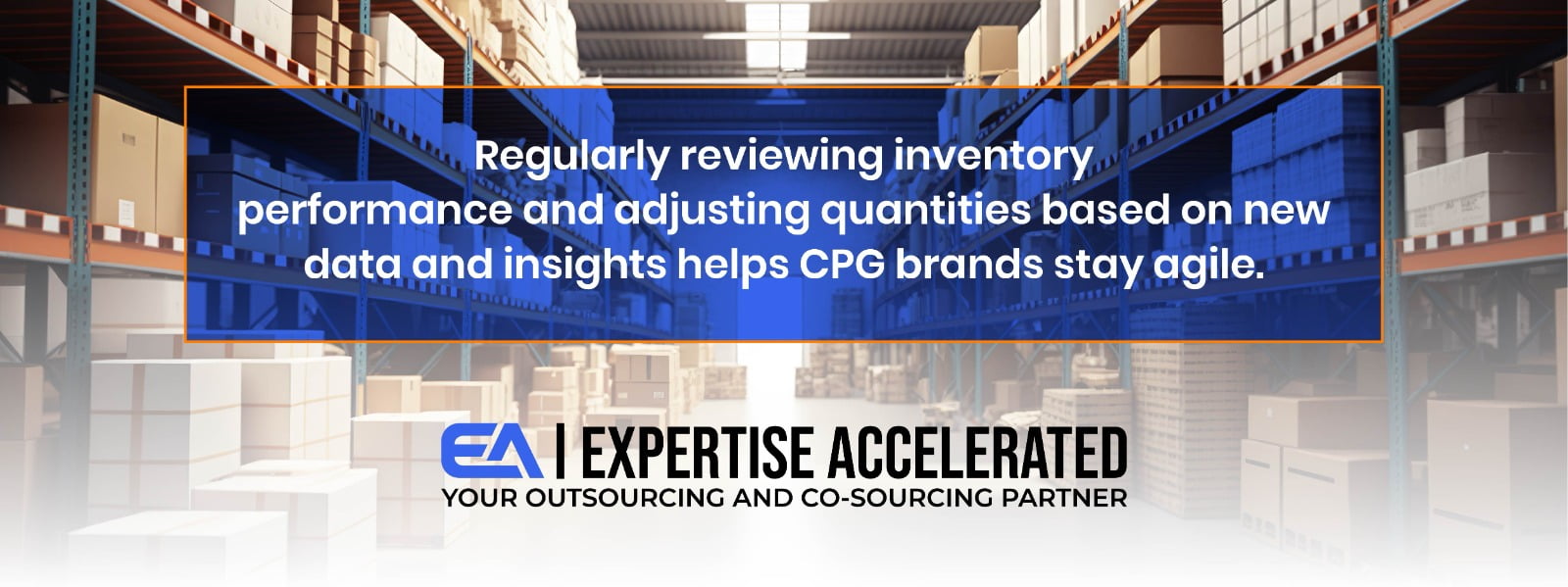How Inventory Management Affects Your Cash Flow Statement (+Tips to Reduce Risk)
Inventory and cash on the cash flow statement are like a delicate see-saw balance. When one goes up, the other goes down.
Inventory is often overlooked. Many companies are reactive (rather than proactive) regarding inventory management which can seriously hurt their bottom line. With inflation and intense competition making consumers pickier about buying CPG products, it’s high time companies improve their inventory management.
In this blog post, we will:
- Break down how inventory affects your cash flow.
- Give you 10+1 tips to reduce risks.
- Show how better inventory management can boost sales.
- Discuss how you don’t have to handle it all by yourself.
Inventory and Cash Flow: A Delicate See-Saw Balance
Inventory and cash flow are like a see-saw, too much focus on one can tip the balance and impact the other. Good inventory management improves cash flow because you have the right amount of inventory in hand to meet the demand. There is no cash tied up in inventory as a non-cash item nor do you have less inventory that is unable to meet demand (causing missed sales). Ultimately, good inventory management increases your bottom line.
When you buy inventory, you pay cash in exchange for it (cash outlay). That’s why the cash figure in the cash flow statement decreases as inventory increases indicating that cash and inventory are inversely proportional.
For example, if you look up cash flow statements over two years and notice an increase in the inventory amount, this increase will be a negative figure in the cash flow statement because there has been a cash outflow. (You have paid cash in exchange of inventory)
On the other hand, a decrease in inventory over the two periods indicates that inventory has been sold. When inventory is sold the company receives cash hence.
What is the problem with too much inventory?
So, what’s the issue with having excess inventory? Can’t we just hold onto it for future periods when demand picks up?
While it might seem like a safe bet to hold onto extra inventory for the future, the costs and risks associated with it often outweigh the potential benefits. Excess inventory means that you have paid cash for its purchase. Your cash has been turned into a non-cash item. You can no longer use that cash to improve liquidity, pay down debt, or re-invest in your business, for example.
Moreover, having inventory more than it is in demand results in storage costs and risk of obsolescence. That’s why it’s usually better to manage inventory more closely to align with actual demand.
Cash is important for running the daily operations of the company. In fact, cash flow is more important.

Cash flow is more important than profit. Do you know, a company can report profit but go out of business simultaneously due to poor cash flows?
Inventory turnover and cash flow
The appearance of inventory on the cash flow statement often reflects the efficiency of your supply chain and inventory turnover. The inventory turnover ratio shows how efficiently a company is managing its inventory. The ratio shows the relationship between the cost of goods sold and average inventory.
Inventory turnover ratio = Cost of goods sold / average inventory
The inventory turnover ratio tells us the number of times inventory is bought and sold in the financial year. A high inventory turnover ratio indicates that the company is selling inventory at a steady rate hence it has a high liquidity (more cash on hand to pay for daily expenses etc.)
The ideal inventory turnover ratio varies in different industries.
Example of inventory turnover ratio
There are two companies A and B with the following inventory turnover ratios:
| A | B |
| Cost of goods sold $50,000 Inventory= $10,000 Inventory turnover ratio= (50,000/10000) 5 times | Cost of goods= $50,000 Inventory= $5000 Inventory turnover ratio= (50,000/5000) 10 times |
A= An inventory turnover ratio of 5 means that Company A sells all its inventory and restocks it five times in a year.
B= 10 times inventory turnover ratio means that company B sells and restocks all its inventory ten times in a year.
Although, the ideal inventory ratio depends on the industry and many other factors, in the example above, Company B has more efficient inventory control. The company is better able to meet demand and respond to market needs. Company B has less risk of inventory staying unsold in the warehouse for a long period. However, company B may have the risk of running out of inventory leading to missed sales and disappointed customers.
It’s important to calculate inventory turnover for several reasons, one being that a business owner can determine operational efficiency compared to similar businesses in the field.
15 Tips to Reduce Risk and Protect Your Cash Flow With Inventory Management
1- Outsource Inventory Management
When you outsource inventory management you get access to inventory specialists who help you in determining optimal inventory levels. This is important because having excess or insufficient inventory incurs costs. Excess inventory ties up your cash flow, while insufficient inventory increases the risk of missed sales opportunities.
Managing inventory efficiently directly impacts the cost of sales and sales. Businesses that heavily rely on selling inventory (retailers, CPG, etc) must have someone to do the heavy lifting for them.
2- Determine/Revise the Right Inventory Quantity
A high level of inventory on the cash flow statement can indicate that too much capital is tied up in unsold goods. When companies have the right inventory quantity they maintain the right balance between having enough stock to meet customer demand and avoiding excess inventory- an essential for a healthy bottom line.
For better inventory management companies must know what to order and when to order. There are software, such as the Inventory Planner, that helps companies determine the right inventory quantity and provides customized inventory performance reports.Not only does the inventory management softwares tell you what to order and when to order, but they also offers insightful, customizable inventory performance reporting.
Optimal order quantity depends on several factors such as your inventory turnover ratio, how often your products are being sold (sales velocity), manufacturing and lead times, shipping times etc.
You already may have an optimal order quantity, however since the market is constantly changing, inventory management strategies should be flexible.

3- Early Payment Discount
Take advantage of early payment discounts from your suppliers. For instance, you buy inventory that you have to pay for in 30 days from the invoice date. Instead of paying in 30 days you can communicate with your supplier and ask him whether he is willing to offer you a 2-4% discount. Suppliers usually agree to this because they too require cash to carry out their business activities.
As a result of early payment discounts, businesses can save a lot in a year, improving their cash flow.
4- Know Your Cash Conversion Cycle
Understand how long it takes to turn sales into cash and work on shortening it.
5- Prioritize Fast-Paying, Profitable Customers
Revenue means nothing if collections take too long.
6- Negotiate Better Supplier Terms
Extend payment terms strategically to improve cash flow without damaging relationships.
7-Manage Inventory Levels Wisely
Excess stock ties up cash and can create liquidity issues.
8- Use Rolling Cash Flow Forecasts
Cash flow forecasts are indeed crucial for inventory management, especially in CPG retail businesses dealing with perishable goods. The forecasts help ensure that inventory levels are aligned with demand so that you don’t have an overstock of inventory leading to the expiration of food items and wasted money.
Planning is key in business and cash flow forecasts help plan your cash flows. An entrepreneur and his team can easily learn what their cash position might look like in 3 months or even 5-6 months from today. You can make important decisions based on them. For example, your cash flow forecasts indicate constraints so you might decide to discontinue or reduce orders of slow-moving inventory items, freeing up cash for more in-demand products.
Continuously update forecasts to anticipate cash shortages and avoid surprises.
What AI does Walmart use?
Walmart Intelligent Retail Lab (IRL) is an AI that Walmart uses to predict sales and manage inventory.
9- AI- Powered Inventory Management
A 2023 report by McKinsey shows that AI tool adoption in retail has surged by 25% annually since 2020, with growth showing no signs of slowing down.
Increasingly companies are using AI-powered inventory management and machine learning algorithms to analyze their inventory data and identify patterns to forecast future cash flows. AI can also incorporate external factors such as macroeconomic conditions, and social media trends to predict a near-accurate demand estimate. This helps companies to adjust their inventory plans accordingly.
Fast-fashion retailer Zara uses AI and RFID (Radio Frequency Identification) technology to optimize inventory management and improve cash flow. By tracking item-level inventory in real-time, Zara gains full visibility into stock levels, enabling rapid replenishment of popular items.
This proactive approach ensures that production decisions align with market needs hence minimizing stockouts improves cash flow.
10- Trade Rebates
Trade rebates are a great way to improve cash flow and manage inventory for scaling businesses. For example, you bought $500,000 in inventory in 2023 from a supplier. You anticipate a 15-20% increase in your sales next year. Instead of the usual 3-4% rebate you can negotiate with your supplier that you plan to increase your sales by 15 to 20% so can he increase the trade rebate by 5-7%. The supplier will not give you cash back, instead, he will give you a credit note to knock it off against the invoice that you will receive from your supplier.
11- Spread Purchase Costs Over Time
If you have a great bond with your suppliers then spreading your purchase costs over time will help protect your cash flows.
For instance, based on your forecasts you anticipate $30,000 of inventory in January, $20,000 in February, and $10,000 in March. Instead of paying for each inventory of what it costs each month ($30k in January, $20k in February..etc), you make a deal with your supplier to spread the costs over time. Hence, in the example above, the total inventory cost in the three months is $60,000 (30,000+20,000+10,000). You will now pay your supplier $20,000 (60,000/3) each month for 3 months.
The great thing about this method is that it lets you manage your inventory and cash flows simultaneously. There aren’t big fluctuations in your cash flow every month.
12- Cross Docking
Cross docking is a way to minimize storage time. Products transfer directly from inbound to outbound transport and they are not kept in a warehouse. Thus reducing inventory holding costs and increasing product turnover (a plus point for perishable goods).
Companies worldwide use cross-dock warehouses to speed up cargo flow to the point of sale.
13- Using an ERP System to Manage Inventory
An ERP system to manage inventory is a great idea, especially for CPG manufacturers or suppliers.
Here’s why:
An ERP system integrates the core functions of your supply chain (finance, logistics, inventory) from within the organization and provides real-time data. Thus the inventory quantities are almost up to date.
Monitoring inventory on the cash flow statement can help you identify trends in purchasing and sales that affect your liquidity.Real-time data about your company’s inventory levels helps you to determine when you should begin your consumer goods manufacturing process without the risk of excess inventory. This is a big pro for the production and operation teams to see what available inventory they have at any time.
Haroon Jafree, CEO of Expertise Accelerated, discusses the advantages of integrating EDI with ERP systems, specifically highlighting the benefits for CPG companies in this video.
In short: An ERP system categorizes your inventory, helping you determine exactly what to order and in the right quantities.
14- Inventory Segmentation & Prioritization
The products within a CPG company’s portfolio will have different demands, sales velocity, and inventory turnover. Hence segmenting inventory by categories like product, sales volume, and margin contribution allows CPG brands to better manage their inventory and cash flow. Inventory segmentation and prioritization ensure that products with high demand are always available.
Companies can also consider back ordering policy or a made-to-order approach for products that are required in low volumes to prevent excess inventory.
15- Tracking and categorizing food waste
CPG companies should make an effort to track and categorize food waste so that they understand what factors are causing it. Tracking food waste will help companies to reduce food waste and make informed decisions about their inventory.
The Often Overlooked Role of Inventory Management in Customer Satisfaction
Unhappy customers mean bad news for the company. One of the main obvious reasons is missed sales. But the impact might not just stop there. Your once-loyal customer might happily shift to, well, let’s just say, someone else (your competitors!!). Hence, resulting in lost future sales and diminished customer retention. That is why inventory management plays an important role in customer satisfaction.
Businesses can prevent dissatisfaction and maintain customer loyalty, ultimately safeguarding their revenue and long-term success.

Inventory management ensures that products are available when customers need them.3 Ways Outsourcing Inventory Management Services Help With Cash Flow
Any company that has poor inventory management practices is leaving money on the table. Theft, damaged goods and inaccurate record keeping are some of the reasons that lead to billions of inventory loss each year in the United States.
Inventory management services help companies determine and maintain optimal inventory levels to help them prevent the costs associated with excess and idle inventories. Such companies have inventory management specialists that help track products, customers, and orders effortlessly. Thus, helping companies avoid stockouts and save time.
Here are 3 ways outsourcing inventory management services can help with cash flow:
1- Increase Sales
Better inventory management means you always have optimal inventory levels to meet demand and avoid missed sales.
Plus when you outsource inventory management you have more time and resources to spend on operational and marketing activities (a.k.a more sales!)
Here’s an example that shows how inventory management leads to increased sales:
| A | B |
| Inventory bought 1000 units ($5000) Inventory sold= 800 units ($4000) Inventory left= 200 units Inventory cost: $5 Total cost of inventory remaining $800 | Inventory bought= 800 units ($5000) Inventory sold= 800 units ($4000) Inventory left= 0 unit Inventory cost: $5 Total cost of inventory remaining $0 |
In the example above, suppose the companies are fast-moving consumer goods companies. Then the remaining inventory in Company A will either lose value or become obsolete in a short time if it’s not sold. Hence, even though both companies made the same profit, the cost of remaining inventory (holding and selling it at less price at clearance) will eat away company A’s profits.
Company B, due to having the optimal inventory levels will have more profit (there’s no excess inventory reducing its bottom line)
2- Make Informed Decisions
Inventory reports help companies make informed decisions about their products.
For instance, a company with optimal inventory levels can set more competitive prices, benefiting from lower holding costs and less pressure to clear excess stock. In contrast, a company burdened with surplus inventory must factor in higher holding costs and adjust prices to move the excess stock.
Effective inventory management and accurate reporting thus enable better pricing strategies and overall financial efficiency.
3- Streamline Reconciliation
Poor inventory practices can complicate the company’s reconciliation process. By leveraging the expertise of external professionals, businesses can reduce discrepancies, errors, and inefficiencies, leading to improved financial accuracy and streamlined operations. A more precise and efficient reconciliation process improves the overall business performance and financial integrity.


